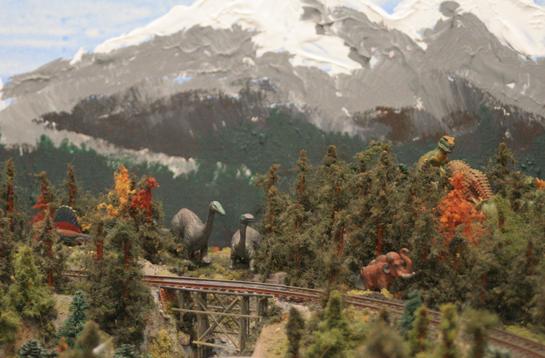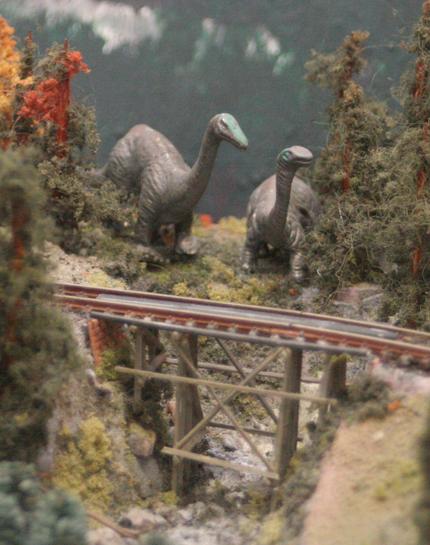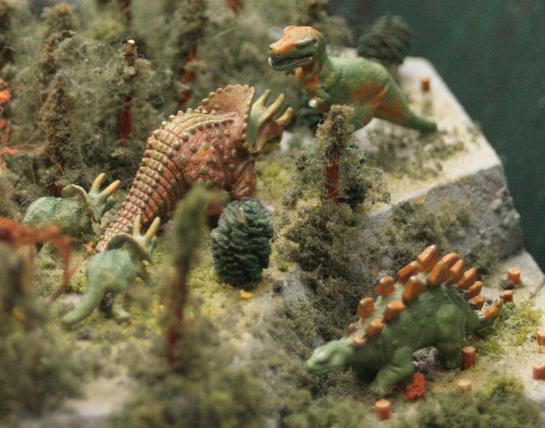The Val Ease Central Railroad ©
Taking Z Scale to the Public Around the World
(Text and photos © Copyright Jeffrey MacHan)
Last Spike: Mesozoic Park...a VEC Vignette!

Nine prehistoric beasts inhabit Val Ease County's most popular tourist attraction. The “Rocket” makes two daily weekday scheduled stops, four on the weekend. Visitors are encouraged to identify the two “un-dinosaurs”. *Do you know who they are?

“Billy” and “Bobby” the brontosauri couple (I never remember which is which) keep a keen eye on “Babblin' Brook Trestle”, a popular photo spot for visiting Japanese tourists.
“Hey, mister, why do you have dinosaurs on your layout?”
My dinosaur collection predates my “Z” endeavors by several years. Ever since I began modelling railroads while in my teens, I have had dinosaurs on my N-scale layouts. But when the “N” finally tipped over to “Z”, my pewter friends (which I discovered measured out to exactly 1:220 scale) found a home on the original VEC – which eventually became “Val Ease West” division.
I noticed from the very first public showing of the VEC that many kids, especially those who didn't show much interest in the trains (girls and toddlers for the most part), broke into grins and excited shouts of “Look! Dinosaurs!”. The call would go out and hoards of young and old alike would stare, wide-eyed at my Z menagerie. Inevitably, a model railroader in the group would ask: “Hey, mister, why do you have dinosaurs on your layout?”.
My usual reply was a feeble, “'Cuz I like dinosaurs”. However, as time passed, I realized that every scene on the VEC, no matter how whimsical, had a purpose. If I couldn't explain the purpose then I had a problem. Finally it dawned on me...the dinos would save Val Ease West.
FLASHBACK ... the VEW Chamber of Commerce launches “Dino Park” design competition
Times were mighty bleak in VEW. The mine was laying off workers, the sawmill and forestry operations were suspended. Who knows when the mill would or even IF it would re-open. The Lodge at Upper Centre Val Ease was practically giving away rooms, things were so slow. The only thing still running in the eastern end of Val Ease County was the “Rocket”, but even it was only making a run every second day. People in town were scared and there was even talk of shops closing and people moving, Heaven forbid!, to the big city, Val Ease East! Something had to be done!
Then one day a little boy licking an icecream cone looked up into the gathering clouds drifting overhead and said to nobody in particular, “Look, there's a dinosaur” Gee, I wish there were dinosaurs in our woods. That would be neat. I bet people would come from all over to see 'em.”
Next thing you know, the Chamber of Commerce had organized a design competition to draw up plans for a new tourist attraction, a sure-fire way to bring “furriners” and other folks into town and even up to the Lodge, no let's call it a “Spa”. And so a competition was held. Plans were made. Unemployed workers rolled up their sleeves. the VECRR engineering department offered to help survey and prepare the site. Local businesses provided concrete, rebar, picks and shovels. The sawmill owner even lent his grader and skidders to the project. Heck, they were only gathering dust anyway. Finally, it was decided to send promotional flyers around the county, around the state, and well, why not, around the nation and even to some “furrin” countries.
It didn't take long before the first telegrams arrived at the Chamber of Commerce asking about this new attraction. Within a month, the first paying guests unpacked their bags at the VEW Hotel. The “Rocket” began to add extra runs to the “Spa” and workers who had earned their living felling trees were now guiding folks to discover the natural treasures of the deep forests, the misty mountains and the rushing streams.
Today, VEW is a bustling rural service centre, thriving on the ever-increasing stream of tourists to the area. The mine is still only running one shift but things are looking brighter at the mill. Some of the tourists were business people who saw an opportunity to modernize and streamline the mill. The farmers are having a hard time keeping up with the demand for fresh produce, meats and poultry. Local artists have become world-famous for their wood carvings and “native” paintings. The future is bright and getting brighter every day all thanks to a fleeting cloud.
Only thing is, nobody has come up with a name for the “Park”, well, until now that is.
Some things are easier said than done!
Trying to come up with a snappy name for the VEW tourist attraction was a great deal more work than I had initially anticipated. Kids at train shows spontaneously shouted “Look mommy (or daddy), Jurassic Park”. That was no good since some Hollywood mogul had already ruined that choice for me. Then I thought, hey, why not check the Internet to see what other names were available. That's when things really got complicated!
The trouble with doing research is that there is a pretty good chance that you'll learn something...and there goes all those fanciful myths you grew up with. I had terrific fun looking up dinosaur web sites for info on my collection. Believe it or not, the most useful and informative site I found was one designed for grade school learners:
Here is the list of my pewter friends from youngest to oldest:
T-Rex and Triceratops lived during the Cretaceous period (144-65 million years ago or MYA), not the Jurassic (206-144 MYA) as a certain popular film would have you believe.
Stegasaurus and Brontosaurus both lived during the late Jurassic period (157-146 MYA). Surprise! Brontosaurus has officially changed names, it appears, to Apatosaurus.
Dimetrodon lived way back in the Permian period (280-245 MYA). Just goes to show that you should never believe what you see in movie theatres. Besides, it is always a good idea to do your homework before presenting your “explanation” to the public. You never know when some bright kid will hit you with real knowledge about the subject and make you look like an ignorant fool, not that I have ever had that experience!
“Oh, Give me a Home, Where the Dinosaurs Roam”
Well, I finally came up with a reasonable name for the VEW tourist attraction...Mesozoic Park. It seemed like as good a choice as any since, except for the youngest and oldest beasts in the collection, all of the others are creatures that roamed our planet during the Mesozoic Era which lasted from 250 million to 65 million years ago. It encompasses three periods: the Triassic Period (250 million to 206 MYA), the Jurassic Period (206 million to 144 MYA) and the Cretaceous Period (144 million to 65 MYA).

In a scene garanteed to delight park visitors, mommy triceratops protects her two “tri-tykes” from a T-Rex looking for a couple of tender T-bones. A nearby stegasaurus hopes to slip away un-noticed. Note: the babies started life as earrings in the Royal Tyrrell Museum gift shop.
*Answer to the “Un-dinosaur” question
You probably came up with the woolly mammoth as one of the two “un-dinosaurs”. That was the easy part. The woolly mammoth disappeared about 3500 years ago at the end of the last major glacial period (ice-age to most of us). In geological terms, this large herbivorous mammal occupies the same modern period as humans. Its remains have been found in North America, Asia, Europe and Africa where it is thought to have evolved. Genetically it is closely related to the Asian elephant.
The second “un-dinosaur” is the Dimetrodon, recognizable by a spiny sail along its back and four, short side-sprawling legs. In fact, the dimetrodon is not a dinosaur but an early meat-eating reptilian ancestor to the mammals. Dimetrodon lived roughly 280 million years ago during the Permian Period (280-245 million years ago), long before the dinosaurs evolved. It disappeared during the Permian Extinction 245 million years ago. Fossils of Dimetrodon have been found in Texas and Oklahoma and trackways have been uncovered in Nova Scotia.